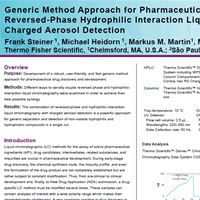
GENERIC APPROACH FOR PHARMACEUTICAL DRUG DISCOVERY AND DEVELOPMENT USING RP HILIC WITH CAD Frank Steiner(1), Michael Heidorn(1), Markus M. Martin(1), Marc Yves Chalom(2), Rodrigo de Sousa Leite(2) Thermo Fisher Scientific, 1-Germering, Germany, 2-São Paulo, SP, BR |
Resumo do Pôster:Liquid chromatographic (LC) methods for the assay of active pharmaceutical ingredients (API), drug candidates, intermediates, related substances, and impurities are crucial in pharmaceutical development. During early-stage drug discovery, the chemical synthesis route, the impurity profile, and even the formulation of the drug product are not completely established but are rather subject to constant modification. Thus, from pre-clinical to clinical development and, finally, to New Drug Application (NDA) submission, a drug-specific LC method must be modified several times. These samples can contain analytes of interest with a wide polarity range which makes their chromatography challenging. A very promising practice in drug discovery is the use of two separate analyses of the same sample; by reversed-phase (RP) LC on the one hand and hydrophilic interaction LC (HILIC) on the other hand. In this work, a generic method approach is presented that addresses common changes during the drug development lifecycle and is applicable to each new drug formulation. The analysis combines gradient RPLC in the first stage and, enabled by organic solvent addition to the eluate coming from the RP column, with gradient HILIC in the second stage. This approach was optimized by combining solvent and flow rate gradients, simple solvent compositions, and UHPLC technology. This allows simplified separation of both hydrophilic and hydrophobic substances within a broad elution window and in a single, short run. Charged Aerosol Detection (CAD) allows near universal detection of non-volatile substances. The performance of the generic method approach is shown with a model sample and an emtricitabine degradation study. The results show that the combination of reversed-phase and hydrophilic interaction liquid chromatography with CAD is a powerful approach for generic separation and detection of non-volatile hydrophilic and hydrophobic compounds in a single run. RP-HILIC-UV-CAD has potential to become the generic method approach of choice for screening in pharamceutical research and development. The generic method setup can be applied to modify existing RPLC screening methods and increase their generic capabilities. |
